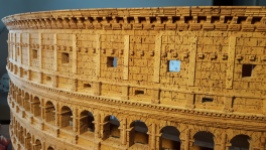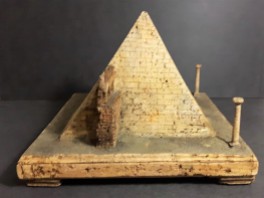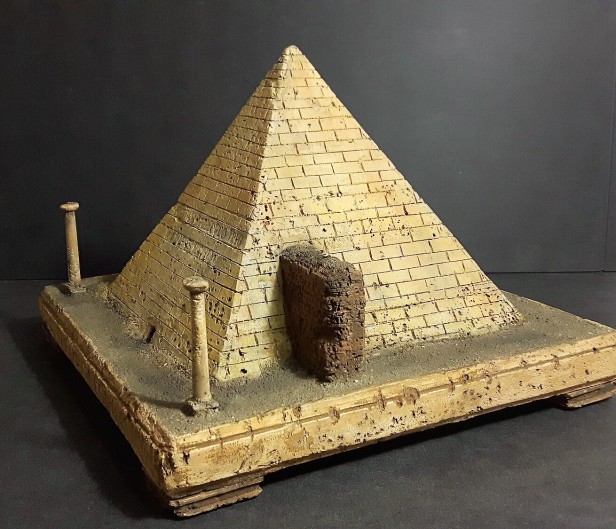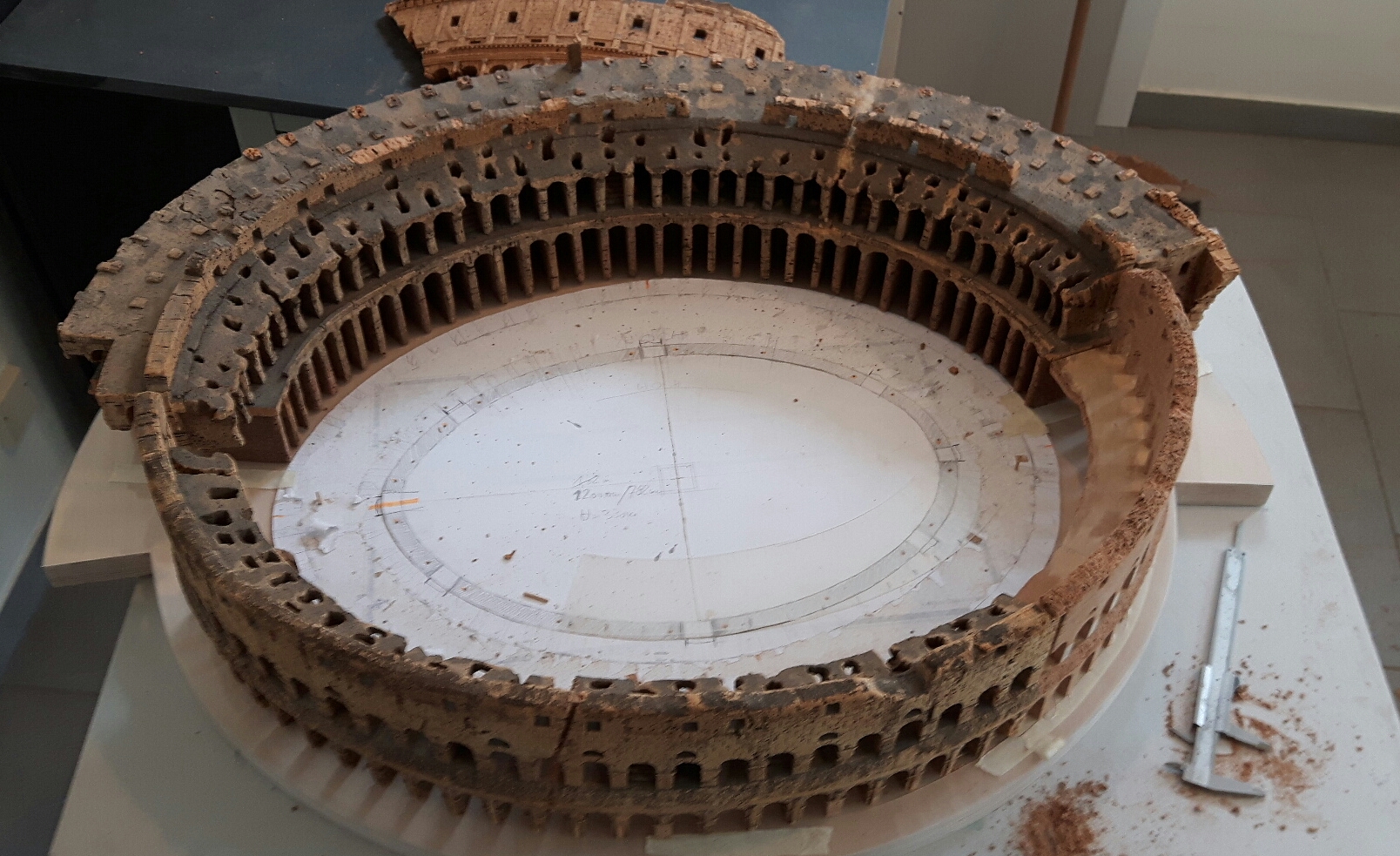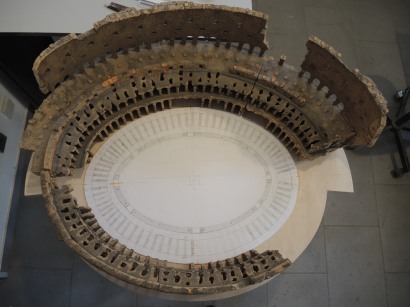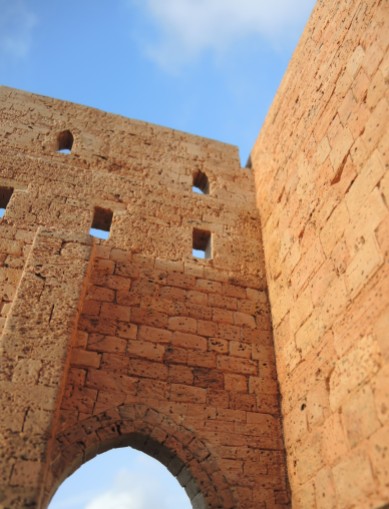
Altertümer


BIRTHDAY
A few temples have already seen the light of day under the hands of Dieter and Malgorzata. However, they are always unique pieces with their own personality. The work is always a great challenge and leads to new craft experiences. The object ( POSEIDON – TEMPLE IN PAESTUM scale 1:100) still needs some additions, but today it leaves the studio for the first time and is kissed by the sun in Malgorzata’s hands.






HOT SPOT
THE COLOSSEUM was certainly once one of the bloodiest spots in the world – we all know its history. However, its ruin gives us the opportunity to change our perspective and think about different aspects.
Dieter and Malgorzata decided to create a new cork model of this unique monument and integrate all their knowledge into the object, with the desire to offer the audience a wide emotional scope for reflection. Let’s see where the journey goes…




LIVING FOR BEAUTY
Cork model of the Temple of Athena in Paestum on display in a private residence in Las Vegas


A NEW MUSEUM
is open to the public. 14 large cork models by Dieter and Malgorzata Cöllen can be seen in the architecture cabinet of the PASSAU STATE LIBRARY





BACK ON STAGE
After a long time in the darkness of the archives, the cork model of the Capitol Temple can now be seen in Cologne in the Church of ST. MARY IN THE CAPITOL and shows the interesting architectural history of this place.




THE GATES ARE OPEN
The cork model of the Pantheon has arrived at the LINDENAU – MUSEUM and is open to the public in the wonderful ALTENBURG CASTLE…








SALVE ROMA
The cork model of the Pantheon in Rome will be presented to the public in the LINDENAU MUSEUM / ALTEBURG in the exhibition „SALVE ROMA“ from October 8th, 2023 to July 28th, 2024.

BEAUTY UNDER CONSTRUCTION
Corkmodel of the Pantheon in Rome, scale 1:100 by Dieter Cöllen and Malgorzata Lagan

A GREAT HONOR
Today Dieter and Malgorzata had the honor of being guests of PROF. DR. HERBERT BLOMSTEDT in Lucerne. As an admirer and collector of their cork models, they were allowed to take a little journey through his eventful life and benefited from his warmth and immense knowledge. Now it’s summer break, but soon he’ll be touring again and conducting the most famous orchestras. Thank you from our hearts and good luck..

THE PANTHEON – CORK MODELL IN PROGRESS
Perfection demands respect – in it´s contemplation as well as in it´s reflection. The work on the cork model is entering now into it´s most important phase – the modeling of the small details…





GOVANNI BATTISTA PIRANESI
and cork models by Dieter Cöllen and Malgorzata Lagan at AHLERS PRO ARTE with an excellent lecture by Dr. Phil.Vera Lüpkes VIDEO






Fotos: Dieter Cöllen, FichterArt

ARCHITECTURE CABINET
After completing the cork model of the , ARCH OF DRUSUS Dieter and Malgorzata integrated it into the architecture cabinet in the old Jesuit library in Passau – In good company…








ON THE ROAD
Dieter and Malgorzata are starting a new project – the Arch of Drusus in Rome. It was part of the Roman aqueduct to supply the BATHS OF CARACALLA. Work begins with the construction of the VIA APPIA, which the arch crosses…

The planning was kindly supported by DR. HEINZ-JÜRGEN BESTE / DAI Rome. Literature: VALERIA DI COLA – L´ARCO DI DRUSO SULLA VIA APPIA.


ALEXANDRIE : FUTURS ANTÉRIEURS
In the stormy seas, Dieter’s cork model of the Pharos of Alexandria shows us the way to the safe port of Marseilles. At the MUCEM it is part of the extraordinary exhibition ALEXANDRIE : FUTURS ANTÉRIEURS, that opens its gates on February 8th, 2023 – Just drop by…







FURTHER STEPS
Work on the Pantheon continues. Here Dieter and Malgorzata assemble the columns of the hall…






DOWNING COLLEGE
Watch here the seminars at Downing College and follow DIETER AND MALGORZATA to Cambridge

JUST COME TO CAMBRIDGE
Dieter and Malgorzata are very honoured to have been invited by DOWNING COLLEGE / CAMBRIDGE to report on their work – JUST VISIT

OPENING SOON
Dieter and Malgorzata have been building large cork models for the architektur cabinet in Passau for several years. With many other objects, they will soon be shown to the public in a wonderful ambience.
The architectural cabinet is part of the Historic Jesuits Library at the State Library of Passau. With the perfectly preserved historic rococo library hall as a starting point the Historic Jesuits Library tries to reconstruct the Jesuits Library in Passau. Jesuitic presence in the city goes back to the year 1612, when the Jesuits founded their institute for higher education in Passau. Also part of the Historic Jesuits Library is a WUNDERKAMMER. Opened in the year 2015 it uses old exhibits still present in the collections of the library as well as permanent loans from important collections of the Bavarian State. The Jesuits had a keen interest in architectural history, which is reflected by a remarkable collection of important literature on the subject. Part of this collection is also presented in the architectural cabinet.

CULTURAL HERITAGE
Dieter as a guest in a scientific stage discussion in the RAUTENSTRAUCH-JOEST-MUSEUM in Cologne about the cultural heritage of Syria and its importance in the future…


SYRIEN – GEGEN DAS VERGESSEN
The RAUTENSTRAUCH – JOEST – MUSEUM in Cologne is showing a unique exhibition on the great loss of Syrian culture in times of peace. The curator JABBAR ABDULLAH has spared no effort in bringing together artefacts, films and photos that have never been shown before. Dieter’s cork model of the TEMPLE OF BEL can also be seen here. The model was started a few days after its violent destruction in 2015 and completed a year later.





AGAINST DESTRUCTION
As we know, targeted activism is the best medicine for mental paralysis brought on by human stupidity… Inspired by their trip to Rome, Dieter and Malgorzata work diligently on the construction of the Pantheon. As the video shows, the shell of the model is almost complete. Fly with us and maybe enjoy the great architecture of the old masters, which can still bring us closer to the beauty of human creativity even after 2000 years…

THE PANTHEON IN ROME
For most people, the mere memory of visiting the PANTHEON in Rome arouses great emotional feelings, combined with a longing to return to this magical place. So why not bring the object to the viewer?! Dieter and Malgorzata will face this great challenge. They plan over a year to produce a cork model scale 1:50, which should also show the complete interior with its elaborate equipment. Let’s watch the two of them at work and follow the single steps of this forgotten craft until completion…



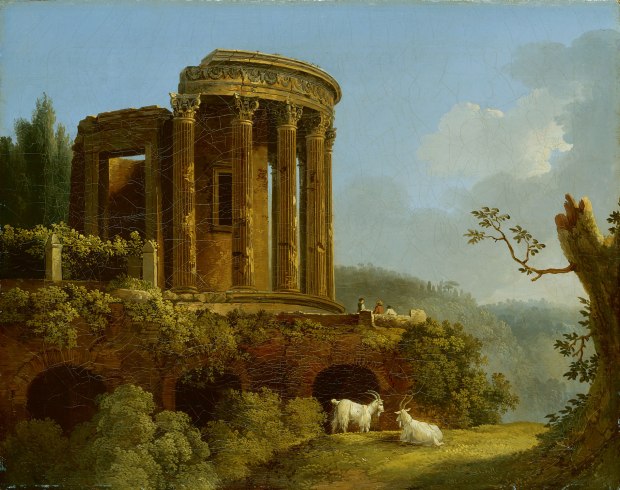
TIVOLI
Until today, the round temple of Tivoli is considered as the ideal of Romanticism for artists and architects. It was modeled in various interpretations by the grand masters of “phelloplastics” and carried across the Alps. Today Dieter and Malgorzata not only restore the few preserved objects, but they also create new cork models of the temple for various requirements. With this they not only keep a forgotten craftsmanship alive, but also try to redirect the viewer’s gaze to perfect proportions and beauty …


BIRTHDAY
After all parts have been fixed in place and the pigment layers have been applied, Dieter and Malgorzata photograph the cork model in optimal daylight. The southern French evening sun, which brings the object to life in warm tones, is ideal for this purpose …


WORKING OPEN AIR
Dieter and Malgorzata work on the columns in the warm French daylight of the Cahors region. A very meditative work …
Meditative work

NORTHERN VISITORS
Yesterday Dieter had charming guests from Finland. The famous TV moderator ELLA KANNINEN and her team visited his “small kitchen” to talk about cork models and filmed Dieter at work.
We all are waiting now for the result that will be shown at the beginning of next year – thank you so much…

SHADE ON THE AUDIENCE
Now the upper section of the facade is nearly finished including the brackets which support the wooden poles for the shading construction. We don’t know much about that, because all that disappeared during the centuries. Watch here a video about an idea how the VELARIUM could have worked.

STONES AND STRUCTURES

THE „NEW“ COLOSSEUM
Since Luigi Carotti built the last cork model of the Colosseum in 1840 nobody toughed that theme again. Today Dieter Cöllen decided to create another object of this incredible monument. He calls his project “Homage á Luigi Carotti” and wants to discover if his artwork can exist beside the quality of the ancient master. The audience is invited to decide…
After getting the plans Dieter starts first to form the oval walls of the Colosseum. Here you can see him working on that basic part. With the assistance of Malgorzata he builds the support structures…

COLOUR AND VERNICE

TWO COLUMNS

A SOLID BASE
i
in the 18th century most of the cork models where manufactured in a hurry due to high demand. Especially the wooden base was often made very carelessly. For that reason many old cork models are in very bad condition today. For Dieter, a solid base is therefore the top priority. After this work is done he begins to restore the cork frame of the object…

RESTORING A BAD TREATED BEAUTY
Dieter´s next restoring project is an ancient cork model of the pyramid of Cestius / Rome. Probably it was manufactured in the studio of Carl May. This object was once a well loved “Souvenir” of the Grand Tour. This model went through several hands and was badly treated during the centuries.
Another new challenge for Dieter…

FINALLY AT HOME…
After its long journey across the ocean the Colosseum safely reached San Francisco. There in a famous private collection it is now the centerpiece of the exhibit surrounded by other models of the 19th century.

THE COLOSSEUM – ICON OF ROME
VIDEO ABOUT WHAT WE KNOW …but never forget – You are visiting the most bloodiest spot in the world…

WEDDING DAY…
work on the Colosseum reaches a significant stage. The monument has to be “married” with its base. 150 points must be glued at the same time connected with 13 wooden dowels.
This demanding action can not be done by one alone. Dieter has support from his friends Stefan and Gerd. Together they achieve a perfect result. This effort has the purpose of creating an unbreakable connection that will last for the next 300 years…










LIVING FOR BEAUTY…
Two beautiful people and their PIRANESEUM

SHADE ON THE AUDIENCE…
Now the upper section of the facade is nearly finished including the brackets which support the wooden poles for the shading construction. We don’t know much about that, because all that disappeared during the centuries. Watch here a video about an idea how the VELARIUM could have worked.

COLUMNS
After the capitals where dipped in different liquids, the elements are glued on the facade. Now the proportions are visible again as well as the order of the columns…



CLAY AND STUFF…
After the drying process of the silicon Dieter prepares the “filling” according to an old recipe. The main ingredient is powdered clay but also other components are necessary to get the best result.
The most important is to get the bubbles out of the liquid. After the drying every single piece must be taken out of the mold carefully. In further steps they must be cleaned with a rotating brush and later coloured with natural pigments…





CAROTTI TALES…
… by Prof. Dr. Valentin Kockel
Not much is known about the life of Luigi Carotti. Models from his workshop are documented for the period from 1830 to 1850. During this time, he worked out of premises in Via delle Vite, and – before or after this period – in Via del Boschetto, as we know from the English labels on his models. Both streets are situated near Piazza di Spagna, where foreign visitors tended to take their lodgings when in Rome.
So far we mainly know of models depicting the ruins of Rome, the usual highlights of every visit: the Arch of Constantine, Colosseum, Temple of Antoninus and Faustina, Temple of Castor and Pollux, Temple of Mars Ultor, Temple of Saturn and the Column of Phocas. Amongst these, the highly elaborate and therefore costly Colosseum stands out the most. Carotti was able to sell this model at least three times. Compared to the models of his predecessors, it represented the actual state of the monument, as it showed the restorations of 1807 und 1823. The choice of depicting the hardly spectacular late Antique Column of the Emperor Phocas on the Roman Forum was probably due to the interests of English travelers: the column was first excavated during the French occupation and a second time in 1817 by the Duchess of Devonshire. The overall increased interest in Greek Doric architecture that prevailed in the 19th century is attested to by models of the temples in Paestum and Sicily.
Initially, Carotti’s models were probably bought by private collectors, but later became part of the collections of learned societies (Edinburgh, St. Petersburg) or museums (Cambridge and Altenburg). The Lindenau-Museum in Altenburg (Thuringia) is the only institution to hold a larger number of models with eight specimen, amongst them a well-preserved Colosseum. Individual models have appeared on the art market, often heavily fragmented. One of these was the model of the Colosseum that is now held by the Piraneseum (San Francisco) and is being restored by Dieter Coellen.
Carotti’s work occurred at a time when interest in cork models was already on the decline. In Rome, he seems to have been the last of his profession whose oeuvre we can still follow at least fragmentarily. Compared to the works of Chichi and Lucangeli (Rome), Padiglione (Naples) or Georg May (Germany) his models appear somewhat dry. Apart from using massive cork as primary building material, Carotti utilized reddish, fired terracotta elements for ornamental details, such as friezes and capitals of the Corinthian order. Their colour has often faded away, but would originally have produced a strangely spotted effect.

THE OUTER WALL
Most of the pillars of the outer wall are lost, broken or not in an upright position. Each of them needs to be restored or rebuilt. A constructed “horizon” helps Dieter with the assembly…


JUST A SOUVENIR?…
In the 18th century even the Carotti´s Cork model of the Colosseum found its way across the Alps in order to teach people about unknown culture and architecture. To get to those unknown historical spots the first tourists spent years for treveling but when they came back home their intellectual status had grown up and this was the key into a new age.. .
.
So lets “hit the dusty trail” together with Cevin McCloud on his GRAND TOUR OF EUROPE. In this 3rd episode of his travel documentation he takes us to Rome where we also can watch Dieter at his open air studio – in the Forum…


HOMMAGE À LUIGI CAROTTI
As we learn from Carottis other Colosseum model at the Lindenau-Museum the old master constructed its base from solid wood, which was the way to do at his time. The problem was that the wood “works” and damages the cork. Today we use plywood for a solid construction.
Dieter does so too but with respect to Luigi Carotti and his way to work he shows the same structure of the surface, even if this is not necessary…

RESURRECTED FROM THE ASHES…

COMPLETE THE OVAL
The next step is to complete one of the six oval construction walls of the Colosseum. This is a very difficult step of reconstruction work because the new part must be fitted exactly between the existing elements.

STEAMING, HEATING, BENDING AND SQUEEZING…
One third of the inner facade is lost and must be reconstructed. For this purpose Dieter has to get the cork in oval shape. He does this in the same way like the old masters did…

CUTTING THROUGH
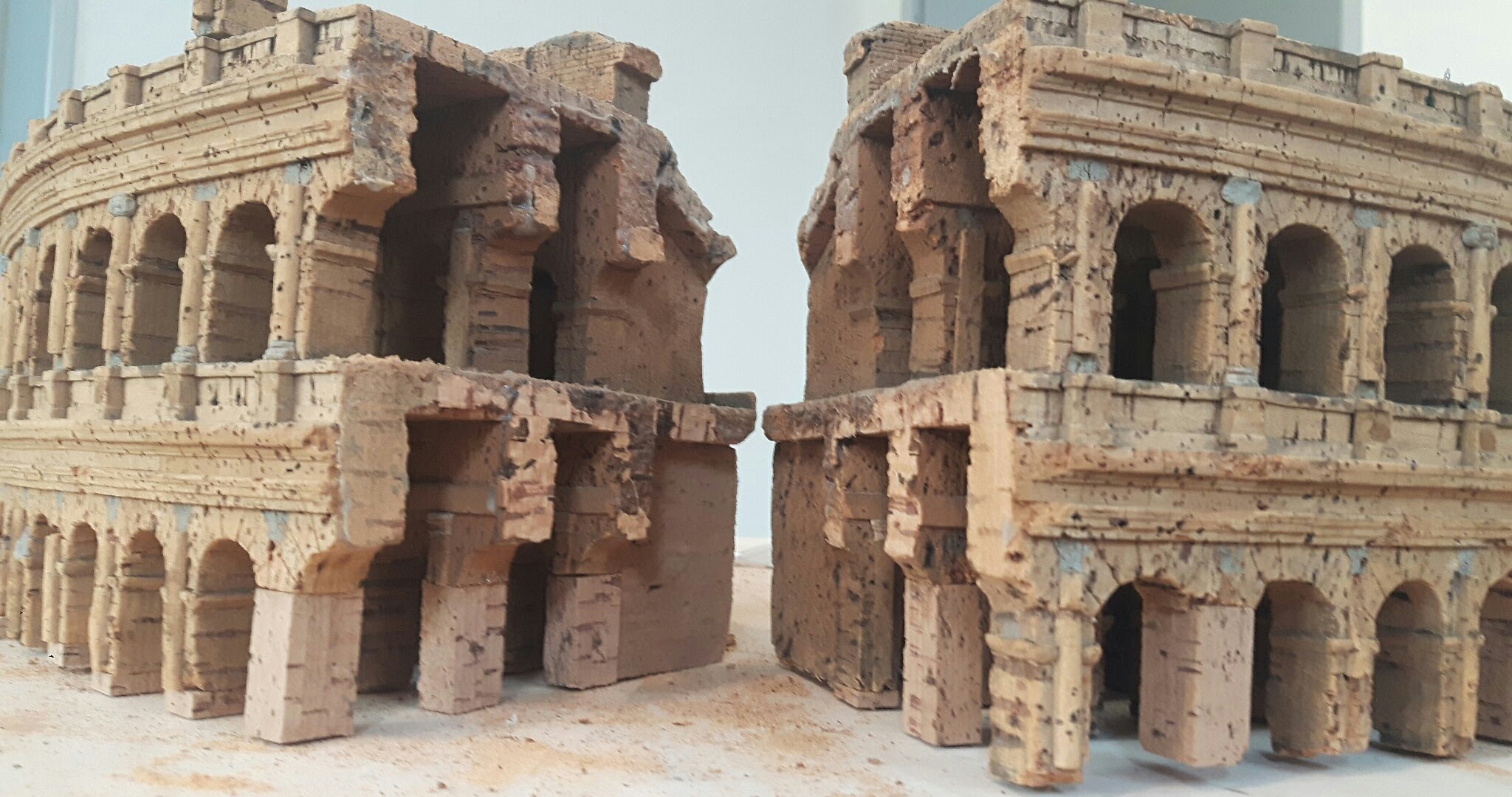


 During the centuries the model was badly treated and broken parts where fitted incorrectly with the wrong glue. Dieter has to cut through the whole structure and work like a surgeon to stabilize the fragile cork and heal the wounded sections…
During the centuries the model was badly treated and broken parts where fitted incorrectly with the wrong glue. Dieter has to cut through the whole structure and work like a surgeon to stabilize the fragile cork and heal the wounded sections…

UPSIDE DOWN

Restoring a ruined ruin…
for the second time Dieter Cöllen is going to restore the Colosseum – another cork model and masterpiece from Luigi Carotti (1842?). In 2017 Cöllen made his experiences with the one in the collection of the Lindenau-Museum in Altenburg/Germany.
This “twin” piece of a private owner is unfortunately in bad condition and it will take Cöllens entire knowledge and perfect cork material to bring it back to that ruin Carotti once created.
Starting with a solid base from plywood Cöllen reconstructs first the missing inner part of the arena.
Than the cork has to be “ruined” and colored with natural pigments even Carotti used at his time.

THE WALL – A PLACE TO MEET…

ZDF – WELCOME TO JERUSALEM

PICTURES OF AN EXHIBITION

The last shots…
Piano, piano…
Best result – Thanks to the audience…
Just the Coliseum…
Starting restauration work at the beautiful Lindenau-Museum today. The cork model was made 1845 by Luigi Carotti. Dieter Cöllen wants the audience to look over his sholder and answers questions about his work and the forgotten technique of „Phelloplastik“ Lindenau-Museum
Come over!
The Wall is growing higher…
The cork model gets slowly it´s charakter. Every single stone is different…
See man at work: Dieter Cöllen on tour…

Foto: Punctum, Bertram Kober
Cork artist Dieter Cöllen will move his studio to the Lindenau Museum, Altenburg, for a week to do restoration work on a cork model of the Coliseum (Luigi Carotti, around 1845). On October 20th, 2017 from 3 pm to 6 pm and October 22th from 10 am to 1 pm. Interested museum visitors have the chance to look over the artits shoulder and learn more about the forgotten art of „phelloplastic“ and the difficulties of cork restoration.
The Mughrabi Gate
The Mughrabi Gate is located on the north side of the Wailing Wall, directly over the Herodian-period gate known as Barclay´s Gate. Over the years the ground level outside Barclay´s Gate rose by many meters above its threshold and was finally walled up in the 10th century. Later in the 12th century a new gate called Bab al-Maghreb was installed at the level of the Temple Mount esplanade. The Gate is open until today and the only entrance to the Temple Mount for non-Muslims.
Here, Dieter Cöllen is going to create a miniature of the gate (scale 1:75) in order to integrate it later into the wall.
Cork – a forgotten material…
Vortrag im Lindenau Museum Altenburg

New Exhibit – Dieter Cöllen / Horst Hahn
One year after it´s destruction. „Reconstruction“ of the Baal-temple in Palmyra finished…
After three months of intensive work, Dieter Cöllen has now completed the cork model of the Baal temple.
He is delighted by the extensive press response – Der Spiegel, NRT , Video – as well as by the positive appraisals of many archaeologists and contemporary witnesses. In his Blog he tried to report on the progress of the works in real time, and put them up for discussion. Even for the invisible details he kept to the archaeological stone plans, so that the model can be used for studying the structural design. However, Dieter also placed great value on colour reproduction, in order not to disregard emotional concerns.
Dieter convinced that the physical presence of this monument is crucial for understanding its history, as well as our own cultural roots.
The catalyst for Dieter´s efforts was his initially powerless rage over such senseless destruction, which he was soon able, however, to transform into creative energy. The model was therefore created entirely independently and without third-party, financial support.
After all that ‘constructive’ time, Dieter now has to give some serious thought to his livelihood again. He has two visions for this:
-
„I also understand my work to be the result of my personal resistance, I can imagine creating editions that can be acquired by collectors with the same interests, so this way they can become a driving force and support for a shared idea.“
-
„The continuing destruction of ancient monuments could demand a gallery of our cultural heritage that is lost or deserving of protection. Models of these objects could be placed in context with their past, as well as with current developments, and lead to improved understanding of history.“
„Of course I would be pleased to hear your ideas on this subject as well. My urge to continue is unbridled, but of course I dream of being able to work towards a greater goal…“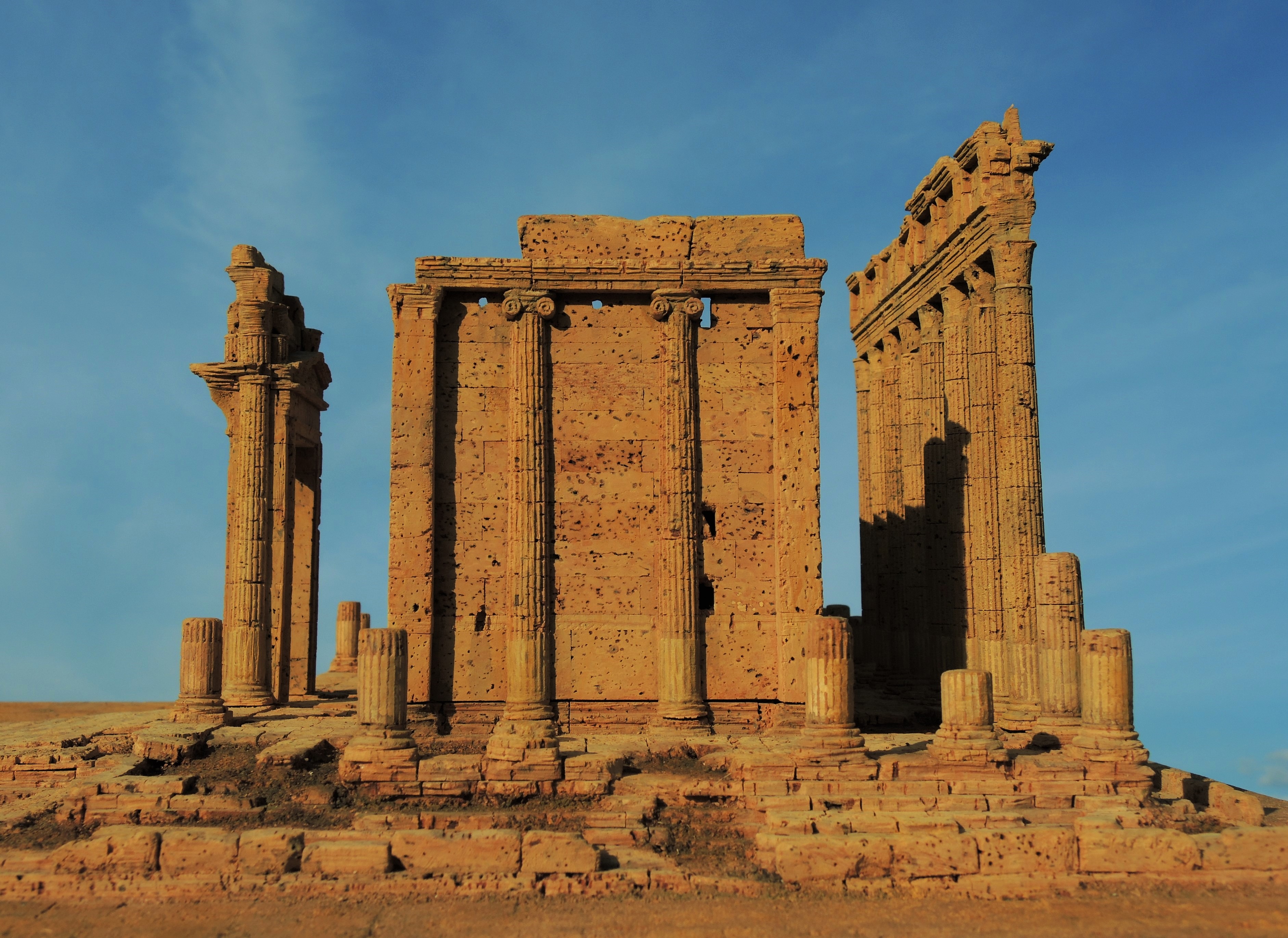
Dieter Cöllen 28.08.2016
Fly around…
finishing the cork work Dieter invites you for a tour around the temple. After one year since it’s destruction we are now able again to enjoy the beauty of this unique and powerful monument.

































